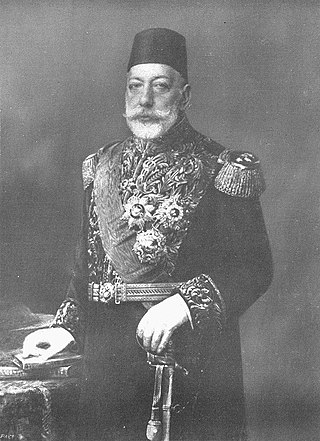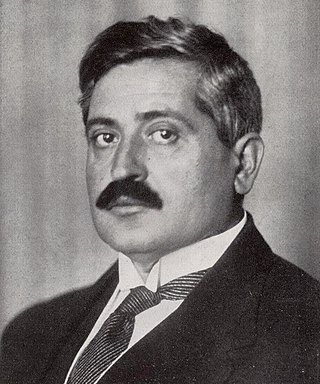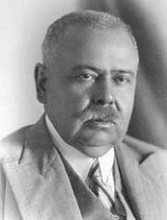
Mehmed V Reşâd was the penultimate sultan of the Ottoman Empire from 1909 to 1918. Mehmed V reigned as a constitutional monarch, interfering little when it came to government affairs, though the constitution was held with little regard by his ministries. The first half of his reign was marked by contentious politicking between factions of the Young Turks, and the second half by war and domination of the Committee of Union and Progress and the Three Pashas.

Mehmed Said Pasha, also known as Küçük Said Pasha or Şapur Çelebi or in his youth as Mabeyn Başkatibi Said Bey, was an Ottoman monarchist, senator, statesman and editor of the Turkish newspaper Jerid-i-Havadis. He served as grand vizier for nine years in total, seven times during the reign of Abdul Hamid II and twice during the Second Constitutional Monarchy. He was known for his opposition to the extension of foreign influence in the Ottoman Empire. He was among the statesmen who were disliked by the Committee of Union and Progress (CUP). However in his last two grand vizierships, Said Pasha was supported by the CUP in the Chamber of Deputies, and his last grand vizierate ended in 1912 with a military memorandum against the Unionists.

Mehmed Talaat, commonly known as Talaat Pasha or Talat Pasha, was an Ottoman Young Turk activist, politician, and convicted war criminal who served as the de facto leader of the Ottoman Empire from 1913 to 1918. He was chairman of the Union and Progress Party, which operated a one-party dictatorship in the Empire; during World War I he became Grand Vizier. He has been called the architect of the Armenian genocide, and was responsible for other ethnic cleansings during his time as Minister of Interior Affairs.

The dissolution of the Ottoman Empire (1908–1922) was a period of history of the Ottoman Empire beginning with the Young Turk Revolution and ultimately ending with the empire's dissolution and the founding of the modern state of Turkey.

The Second Constitutional Era was the period of restored parliamentary rule in the Ottoman Empire between the 1908 Young Turk Revolution and the 1920 dissolution of the General Assembly, during the empire's twilight years.

Ahmed Muhtar Pasha also spelled Ahmed Mihtar Pasha was a prominent Ottoman field marshal and Grand Vizier, who served in the Crimean and Russo-Turkish wars. Ahmed Muhtar Pasha was appointed as Grand Vizier in July 1912 at age 72, largely due to his prestige as an old military hero.

The First Constitutional Era of the Ottoman Empire was the period of constitutional monarchy from the promulgation of the Ottoman constitution of 1876, written by members of the Young Ottomans, that began on 23 December 1876 and lasted until 14 February 1878. These Young Ottomans were dissatisfied by the Tanzimat and instead pushed for a constitutional government similar to that in Europe. The constitutional period started with the dethroning of Sultan Abdulaziz. Abdul Hamid II took his place as Sultan. The era ended with the suspension of the Ottoman Parliament and the constitution by Sultan Abdul Hamid II, with which he restored his own absolute monarchy.

The 1913 Ottoman coup d'état, also known as the Raid on the Sublime Porte, was a coup d'état carried out in the Ottoman Empire by a number of Committee of Union and Progress (CUP) members led by Ismail Enver Bey and Mehmed Talaat Bey, in which the group made a surprise raid on the central Ottoman government buildings, the Sublime Porte. During the coup, the Minister of War, Nazım Pasha, was assassinated and the Grand Vizier, Kâmil Pasha, was forced to resign. Soon after the coup, the government fell into the hands of the CUP, now under the leadership of the triumvirate known as the "Three Pashas", made up of Enver, Talaat, and Cemal Pasha.

The 31 March incident was a political crisis within the Ottoman Empire in April 1909, during the Second Constitutional Era. The incident broke out during the night of 30–31 Mart 1325 in Rumi calendar, thus named after 31 March where March is the equivalent to Rumi month Mart. Occurring soon after the 1908 Young Turk Revolution, in which the Committee of Union and Progress (CUP) had successfully restored the Constitution and ended the absolute rule of Sultan Abdul Hamid II, it is sometimes referred to as an attempted countercoup or counterrevolution. It consisted of a general uprising against the CUP within Istanbul, largely led by reactionary groups, particularly Islamists opposed to the secularising influence of the CUP and supporters of absolutism, although liberal opponents of the CUP within the Liberty Party also played a lesser role. The crisis ended after eleven days, when troops loyal to the CUP restored order in Istanbul and deposed Abdul Hamid.

Mehmed Kâmil Pasha, also spelled as Kamil Pasha, was an Ottoman statesman and liberal politician of Turkish Cypriot origin in the late-19th-century and early-20th-century. He was the Grand Vizier of the Empire during four different periods.

Ali Rıza Pasha (1860–1932) was an Ottoman military officer and statesman, who was one of the last Grand Viziers of the Ottoman Empire, under the reign of the last Ottoman Sultan Mehmed VI, between 14 October 1919 and 2 March 1920.

Mahmud Shevket Pasha was an Ottoman generalissimo and statesman, who was an important political figure during the Second Constitutional Era. During the 31 March Incident, Shevket Pasha and the Committee of Union and Progress overthrew Abdul Hamid II after an anti-Constitutionalist uprising in Constantinople. He played the role of a power broker after the crisis, balancing the various factions of the Young Turks and the army. As War Minister he played a leading role in military reform and the establishment of Air Divisions. Shevket Pasha became Grand Vizier during the First Balkan War in the aftermath of the 1913 coup d'état, from 23 January 1913 until his death by assassination.
The Freedom and Accord Party was a liberal Ottoman political party active between 1911 and 1913, during the Second Constitutional Era. It was the most significant opposition to Union and Progress in the Chamber of Deputies. The political programme of the party advocated for Ottomanism, government decentralisation, the rights of ethnic minorities, and close relations with Britain. In the post-1918 Ottoman Empire, the party became known for its attempts to suppress and prosecute the CUP.

The 1912 Ottoman coup d'état was a military coup in the Ottoman Empire against the Committee of Union and Progress (CUP) government by a group of military officers calling themselves the Saviour Officers during the dissolution era of the Ottoman Empire.

Early general elections were held in the Ottoman Empire in April 1912. Due to electoral fraud and brutal electioneering, which earned the elections the nickname Sopalı Seçimler, the ruling Committee of Union and Progress won 269 of the 275 seats in the Chamber of Deputies, whilst the opposition Freedom and Accord Party only won six seats.

The Committee of Union and Progress, refers to several revolutionary groups and a political party active between 1889 and 1926 in the Ottoman Empire and the Republic of Turkey. The foremost faction of the Young Turks, the CUP instigated the 1908 Young Turk Revolution, which ended absolute monarchy and began the Second Constitutional Era. After an ideological transformation, from 1913 to 1918, the CUP ruled the empire as a dictatorship and committed genocides against the Armenian, Greek, and Assyrian peoples as part of a broader policy of ethnic erasure during the late Ottoman period. The CUP and its members have often been referred to as Young Turks, although the movement produced other political parties as well. Within the Ottoman Empire its members were known as İttihadcılar ('Unionists') or Komiteciler ('Committeemen').

Halil Menteşe (1874–1948) was a Turkish government minister and politician, who was a well known official of the Committee of Union and Progress (CUP). He was the Minister of Foreign Affairs and the President of the Chamber of Deputies in the last years of the Ottoman Empire, and also served as an independent deputy from İzmir in the Republic of Turkey. He was one of the people most directly responsible for the Armenian genocide.
The Taksim meeting alternatively known as the Taksim Plot and less commonly as the Taksim Assembly was a secret meeting held in January 1912 by Albanian nationalist deputies of the Ottoman parliament and other prominent Albanian political figures. The event gets its name from Taksim Square because of the location of the house where it was held. The meeting was organized on the initiative of Hasan Prishtina and Ismail Qemali, Albanian politicians, who invited most of the MPs of Albanian origin and aimed at launching an armed general uprising in Albanian territories against the central government headed by the Committee of Union and Progress (CUP). The meeting followed two other Albanian uprisings of 1910 in the Vilayet of Kosovo and 1911 in the mountains of upper Shkodra. The Taksim meeting resulted in an uprising the same year, with armed uprisings in Shkodër, Lezhë, Mirditë, Krujë and other Albanian provinces, which exceeded the organizers' expectations. The biggest uprising was in Kosovo, where the rebels were more organized and managed to take over important cities like Prizren, Peja, Gjakova, Mitrovica and others.

The Shevket Pasha cabinet was headed by Grand Vizier Mahmud Shevket Pasha. It was formed on 23 January 1913 after the Raid on the Sublime Porte, which occurred due to Kamil Pasha's attempt to sign a peace treaty would have ended the First Balkan War by giving most of Turkey-in-Europe to the Balkan League. Within two weeks of the coup, Shevket Pasha broke the armistice and resumed fighting but failed to recapture land. In the end the government had to abide by the Treaty of London, which gave up the city of Adrianople to Bulgaria, one of the Ottoman Empire's original capitals. Following Shevket Pasha's assassination on June 12, Said Halim Pasha was brought in to form a new government after Shevket Pasha's assassination.














